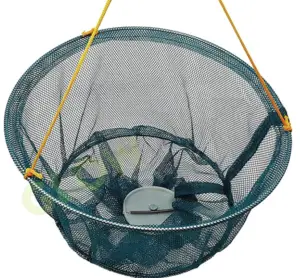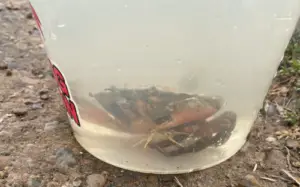
Crabbing Tips: How And Where To Go Crabbing
As a family we go crabbing everywhere we go on holiday! This includes Norfolk, Suffolk, Devon and Wales. Please read on for crabbing care kits – it’s important the crabs are looked after when you catch them.
What you will find on our guide (Tap to get to that section)
Getting Started with Crabbing
What is Crabbing?
Crabbing is a delightful and rewarding activity that involves catching crabs along coastal areas. It’s an excellent way to enjoy the outdoors, whether you’re with family, friends, or even on a solo adventure. Crabbing can be done from the shore or a boat, making it accessible to everyone. This activity is popular in many parts of the world, including the UK, the United States, and Australia. Whether you’re a seasoned angler or a complete beginner, crabbing offers a fantastic opportunity to connect with nature and potentially catch some delicious seafood. The thrill of catching crabs and the joy of spending time by the water make crabbing a favorite pastime for many.
Crabbing Equipment
Essential Gear
To embark on your crabbing adventure, you’ll need some essential gear. First and foremost, a crab line or net is crucial. A crab line is a long line with a bait bag attached to one end, perfect for luring crabs. Alternatively, a crab net, which is a circular net, can be used to scoop up crabs directly. Bait is another key component; options like shellfish, squid, and fish are excellent choices to attract crabs. A bucket is necessary for temporarily housing your catch, ensuring they stay safe and contained. While not mandatory, gloves can be very useful for handling crabs, protecting your hands from their sharp claws. With this basic crabbing equipment, you’ll be well-prepared to start catching crabs and enjoying this engaging activity.
Tips for Catching Shore Crabs
Selecting the right bait is crucial for a successful crabbing experience. Shore crabs are particularly attracted to fresh and smelly bait. Fish carcass, razor clams, and squid are among the top choices, as their strong scent can lure crabs from a distance. Chicken parts and other meaty baits can also be effective. Using a bait bag is highly recommended; it can be attached to your crab line or net and filled with your chosen bait. This not only keeps the bait fresh but also helps to concentrate the scent, attracting more shore crabs to your spot. By choosing the right bait and using a bait bag, you’ll increase your chances of catching a good number of crabs.
1 – Use a crab trap and not a line
There are two types of crabbing setups. One where you need the crabs to hand on and one that is a drop net (See the best one to use here). Crab rings are another effective option for trapping crabs. Drop nets work better but they are not considered as a traditional method. Box crab traps are an affordable and durable option for crabbing. If you have kids it‘’s all about catching loads and making it easy – a drop net will do this.
IMPORTANT: If you are using a drop net check it thoroughly before you pack up and go. They often catch smaller fish and clear shrimp which are hard to see, it’s important these get safely returned to the water. Usually dropping the net back in the water will be enough to get them to swim off – DO NOT pour them from a bucket from a height.

IMPORTANT: If you are using a drop net check it thoroughly before you pack up and go. They often catch smaller fish and clear shrimp which are hard to see, it’s important these get safely returned to the water. Usually dropping the net back in the water will be enough to get them to swim off – DO NOT pour them from a bucket from a height.
Use a fishy crab bait
I see a lot of people using bacon for crabbing, but I am convinced that various types of crab bait, especially fish-based baits, catch better – the smellier the better. Try going to local fishmongers and they will have some offcuts that will be perfect for crabbing. Using fresh bait, such as raw chicken, fish carcass, or razor clams, can significantly enhance your crabbing success.
I use as much as I can get in the bait net for maximum attraction. It’s all about getting as many crabs in your spot as possible.
3 – Find the deeper water
This is where you’ll find more crabs! If you arrive before the tide is really up look at the bank below you, carefully if you’re on a quay! Look for the spots that go deeper rather than the high mud banks and these spots will not only get water in the quick, but they should also hold more crabs. Using crab lines as essential equipment can help you reach these deeper spots effectively.
Spots, where boats have been, will be good spots once the boats have gone. If the boats have been in the mud then they will have left exposed natural food when they lift up in the water. Ensure your fishing line is of suitable length to reach the seabed for better crabbing results.
4 – Look for structures in the water
This comes from my love of fishing – anywhere crabs can hide, like fish, they will. If you cannot find deeper water then look for poles in the water or any other features. Pyramid crab traps are particularly effective for trapping crabs around such structures. These traps are great for fishing off a harbour wall – just keep your children away from the edge!
On a recent trip, albeit in Suffolk, we found loads of crabs, including some big ones, around a water inlet pipe in the water. It was littered with them. We caught absolutely loads from the spot. We’d been around 10 meters away trying and only caught the odd crab.
5 – Find a good spot before you go
There’s lots of information online about the best crabbing spots where you are. Have a look around and do some research before you go. As a regular visitor to Norfolk, I have put together the best crabbing spots in Norfolk guide. The east coast, with its scenic beauty and attractions like Crail Harbour in Scotland, is also a desirable destination for crabbing.
If you are in Devon or elsewhere look online and see where the best and most popular spots are. The west coast offers unique crabbing opportunities, especially for species like Dungeness crabs, using specialized equipment such as Pacific crab traps.

Look after the crabs
One of the most important things is to make sure the crabs are cared for in your bucket.
Here are some key things to remember
- Handling – Pick them up gently, hold them by the shell and pick them up from behind so they don’t pinch you. If you are an adult a pinch from a small blue crab won’t really hurt you. It is important to be confident when picking them up.
- In the bucket – Don’t keep too many in the bucket at once as they will start fighting. They need water and space. Once you have caught 10 reasonably sized crabs, pop them back, refresh your water and catch another 10. You can always keep count of how many you catch and you do not need to keep them all in the same bucket for hours.

- Letting them go – Let them go as close to the water’s edge as you can, don’t leave them to run around and find the water. Slowly let the water out with the crabs in it, ideally into some shallow water. Make sure all the crabs are mentally released into the water. If you’re on a quay get them as close to the water as you safely can before releasing them – or look for so steps down where you can go safely to release them. In this case, let the adults put them back and not the children!
How to crab – A beginners guide
If you’ve never crabbed before then fear not, our guide will have you at an expert level in no time at all!
- Get your bait and equipment ready – Grab a drop net here or simply pick one up from a local shop near where you are going. By some bait too.
- Pick your spot – As mentioned in my crabbing tips, get to your spot nice and early and try and find some deeper water if you can. If not look for any structures in the water that you can get close to without getting stuck – remember the water will move significantly on the tide.
- Bait up – Get your bait out and in the net securely – or you will lose it!
- The drop – Slowly lower the net into the water. Imagine it is a parachute when it hits the water. You need it to be nice and open with the weight pulling down and the bait in the middle. If it gets tangled around the edge you won’t catch anything.
- Leave it – Around 5 minutes is a good starting point, pull the line up to the water level and see if you have anything if you can safely look over the end, if not pull it all the way up. If you have nothing then lower it in and try 10 minutes the next time.
- Look after the crabs – As mentioned in the above section on looking after crabs, take care of them. Don’t get too many in your bucket and safely let them go.
- Finishing up – Once you are pulling the net in for the last time give it a thorough check over and make sure there are no tiny crabs, shrimp or fish in the net.
- Cleaning your equipment – Once back it is well worth giving your net a soak in some water from an outside tap or preferably a water butt. This will get the saltwater off and prolong the life of the net. Make sure you let it dry completely before storing it in a dry bag.
I hope you enjoyed this post and are thinking about catching crabs on tour next holiday. It is one of our family’s favourite things to do when we head to Norfolk. You can see my guide to Norfolk fishing lodge breaks here. It’s a great place to go on holiday. We have also done crabbing in Devon and Angelsea. If you’ve never tried, head out and have a go!
Latest posts from our blog


